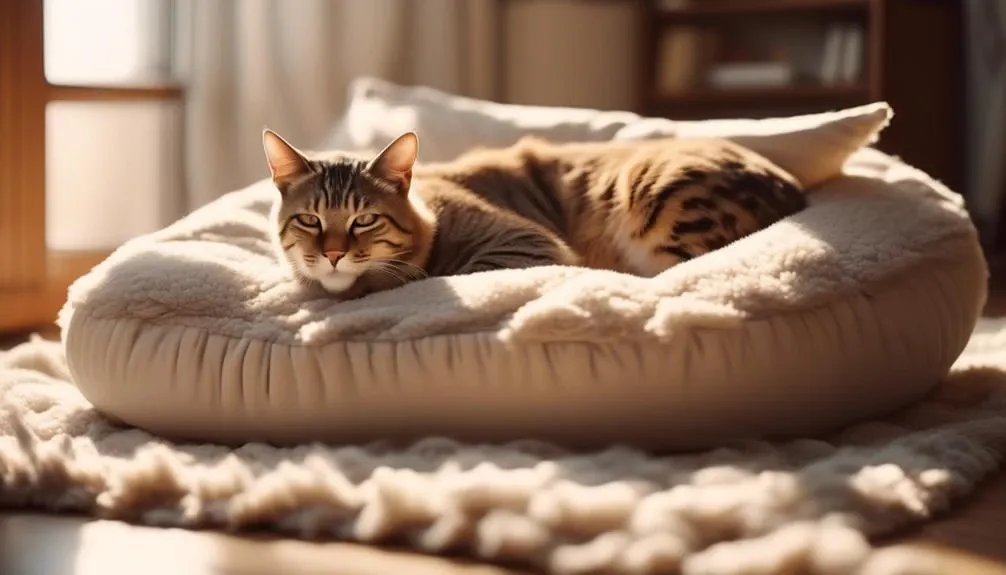The Best Fluffy Pancakes recipe you will fall in love with. Full of tips and tricks to help you make the best pancakes.

Feline arthritis is a debilitating condition that can significantly impact a cat's quality of life. As responsible pet owners, it is our duty to explore effective ways to alleviate their pain and discomfort.
In this article, we will delve into expert tips and strategies for managing feline arthritis, offering practical insights and recommendations that can make a real difference in your furry friend's well-being.
From weight management and dietary supplements to creating a comfortable environment and promoting increased exercise, these valuable tips will empower you to provide the best care for your cat.
So, let's uncover these expert secrets and discover how we can ease your cat's pain and improve their overall health.
Key Takeaways
- Consult with a veterinarian to determine if weight loss is necessary for cats with osteoarthritis and ensure proper portion control with measured food.
- Consider using weight loss cat food formulations that have fewer calories and added fiber or protein to help your cat shed excess pounds.
- Some veterinarians recommend dietary supplements like glucosamine, chondroitin, and omega-3 fatty acids to improve joint health and reduce inflammation in arthritic cats. However, always check with your veterinarian before giving any supplements.
- Provide comfort and support for your cat by offering warm and cozy sleeping areas, elevating food and water bowls, and using large litter boxes with low edges for easy access.
Weight Management for Arthritic Cats
Weight management is essential for arthritic cats in order to alleviate pain and improve their overall quality of life. Weight loss strategies and portion control are key components of an effective weight management plan for these cats.
Consult with a veterinarian to determine if weight loss is necessary for your cat. Measure your cat's food using a measuring cup to ensure proper portion control. Consider using weight loss cat food formulations that have fewer calories and added fiber or protein.
Avoid feeding your cat human food, as it is often high in calories and lacks necessary nutrients. Limit the amount of treats given to your cat and opt for healthy, homemade options without added seasonings.
Combining weight loss food with portion control will help your cat shed excess pounds and improve their arthritis symptoms.
Dietary Supplements for Joint Health
Dietary supplements can play a beneficial role in improving joint health and reducing inflammation in cats with osteoarthritis. Glucosamine, chondroitin, and omega-3 fatty acids are commonly recommended supplements for cats with arthritis. These supplements can help improve joint health and reduce inflammation.
It is important to consult with a veterinarian to determine the most suitable supplement for your cat's condition. Look for supplements that are specifically formulated for cats and meet quality standards. Follow the recommended dosage instructions provided by the veterinarian or supplement manufacturer.
Early detection and treatment are crucial for managing arthritis in cats. Proper feeding instructions, including portion control and a balanced diet, also play a role in managing arthritis pain in cats. By incorporating dietary supplements and following proper feeding instructions, you can help improve your cat's joint health and reduce their arthritis pain.
Comfort and Support for Arthritic Cats
Arthritis in cats can be managed effectively by providing comfort and support to alleviate their joint pain and improve their quality of life.
One way to provide comfort is by offering warm and cozy sleeping areas for your cat, such as self-warming beds or beds with memory foam. It is important to choose beds with lower edges for easy access and larger sizes for comfortable stretching. You can also consider placing extra cat beds in different locations around your home to ensure your cat always has a comfortable spot.
Additionally, elevating your cat's food and water bowls can help reduce strain on their joints while eating. You can achieve this by using elevated bowls or simply placing a soft towel or mat under the bowls for added comfort.
Litter Box Modifications for Arthritic Cats
To accommodate cats with limited mobility, it is important to make litter box modifications that provide easy access and comfort for arthritic cats.
For senior cats with arthritis, consider using litter box alternatives that are easier on their joints. Look for litter with softer textures or use litter box liners to provide added cushioning.
Additionally, use large litter boxes with low edges to make it easier for your cat to enter and exit the box. Place the litter boxes on the same floor where your cat spends the most time to avoid the need for stairs.
It may also be helpful to add extra litter boxes throughout the house for easy access.
Increased Exercise for Arthritic Cats
Regular exercise is important for arthritic cats to help with weight loss and improve joint mobility. Engaging your cat in moderate, low-impact activities can have a positive impact on their overall health.
Consult with a veterinarian to determine suitable exercises for your cat's condition. Keep exercise sessions short and avoid activities that require jumping or quick changes in direction to prevent further strain on their joints.
Interactive toys can be a great way to encourage movement and provide mental stimulation for your cat. Playing with your cat using these toys can help strengthen their muscles and ligaments around the joints.
Remember to always monitor your cat during exercise and consult with a professional for guidance on the best exercise routine for your arthritic cat.
Conclusion
In conclusion, feline arthritis is a common condition that can greatly impact a cat's quality of life. By implementing weight management strategies, considering dietary supplements, providing comfort and support, and making necessary modifications, cat owners can help ease their pet's pain and improve their overall well-being.
A noteworthy statistic to consider is that approximately 60% of cats over the age of six are affected by arthritis, highlighting the importance of early detection and proactive management.








